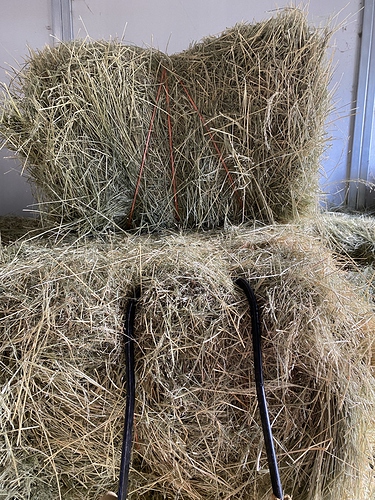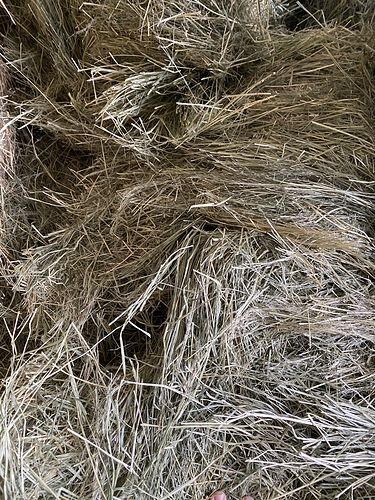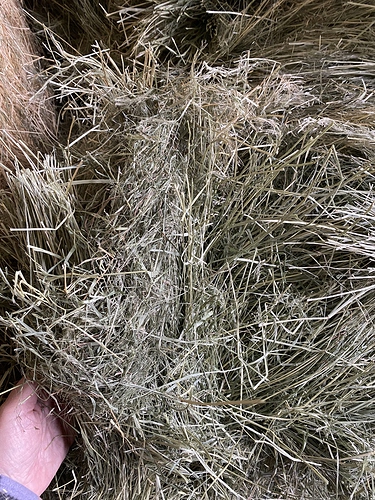Somewhere, some time ago, I read fine stemmed hay is more difficult for horses to masticate and can cause impaction colic. We try to only feed second and third cutting orchard grass.
I was curious about teff for my IR horses. The farmers I talked to talked about how difficult it is to produce and bale properly, which I found interesting. I’m in the Midwest.
Initially our hay guys were targeting mid July for cutting, but it ended up being in August. I don’t know if that was because they didn’t get it in the ground when they wanted or if it grew longer. In terms of the steminess - it’s still very soft compared to all the other hay in the barn. It does hold in flakes decently well. The teff I had seen a couple years earlier seemed to fall apart easier than this stuff. Charlie is all about it and it definitely helped get (and keep) his weight down.
Tell that to multiple vets, google and my pony who almost died a few times on a high quality orchardgrass that was very fine stemmed. My explanation may be crude but I’ve heard the same message from multiple sources.
I think horses can have an impaction on any hay. Make sure to check for dental issues in your horse as that can contribute to impaction risk.
I have fed coastal for many years and only had one impaction in all that time. It scared the daylights out of me and I have been feeding alfalfa a lot more ever since… but around here, most of the people I know feed coastal or Tifton without issue.
I’ve debated on driving up north and filling my truck and trailer with hay but it might be difficult to get it back to Florida without getting rained on at some point during the trip. Pretty much impossible to do right now as we get so much rain. I can’t even drive to Ocala and back without hitting rain.
Teff hay does look similar to coastal. I did try orchardgrass rounds and it gave my one mare fecal water syndrome so that wasn’t a successful hay for me either.
it’s not wrong, exactly. Finer stems are more difficult to chew. It’s not a problem for horses with good teeth, especially if they’re given a bit of time to acclimate. It can definitely be a problem for horses without good chewing surfaces. But, “finer” has to be qualified  Some grasses are finer-bladed compared to others, but there’s a range. Anything not properly chewed could potentially contribute to an impaction. Coastal Bermuda is in a class of its own, affecting even horses with good teeth, because it’s both fine-stemmed (even relative to more fine cuttings of other grasses), and higher in indigestible fiber, which leads to problems trying to go through the ileal junction (which, fwiw, is where tapeworm impactions tend to happen)
Some grasses are finer-bladed compared to others, but there’s a range. Anything not properly chewed could potentially contribute to an impaction. Coastal Bermuda is in a class of its own, affecting even horses with good teeth, because it’s both fine-stemmed (even relative to more fine cuttings of other grasses), and higher in indigestible fiber, which leads to problems trying to go through the ileal junction (which, fwiw, is where tapeworm impactions tend to happen)
Yep, that’ll definitely cause what you see.
I actually tried to find something about that before I commented, and couldn’t find anything. If you have a cite for it I’d love to read it.
That was much more likely to be about incompletely chewing a finer hay, than it not being a coarse hay. Hay isn’t really digested in the stomach anyway, so a lower pH wouldn’t impact that. Besides, the saliva produced by chewing hay (and grass) helps buffer stomach acid, which is a good thing
I boarded for 20-ish years at a barn with anywhere from 15/16 to, at its peak, around 30 horses, and for most of those years the only hay fed was Coastal. It was excellent quality, cut almost monthly, from SC (barn in NC) and despite the whole management setup being more conducive to colics (turnout for 1-2 hours a day, most horses used for lessons 1-2 hours a day, many boarder horses ridden 3-7 days a week), there were very, very few colics in general, and several of those were strangulating lipomas (the classic older gelding) so unrelated to diet.
The quality of the Coastal makes a big difference for sure.
Standlee teff pellets
I have also been using these for the last five years or so, we have one rescued older Morgan mare, she is 25. Because of her prior life her teeth are pretty much gone. She gets soaked Teff pellets three times a day.
Also the miniatures get a hand full to the soaked pellets twice a day
The pellets are soaked in cold water in the summer, hot water in the winter. When the Teff pellets are soaked they expand about tens fold or more.
As for Teff hay or pellets nothing around here refuses them, again none of the horses has free choice access but are fed about four pounds five times a day. We are feeding four horses, three miniatures
The two rescued Morgan are fed their hay in a 100 gallon water trough which one really likes to see what on the bottom I guess as usually there is about a quarter of the hay pitched out on the ground which is raked up then fed to the goats who are at the fence pleading for the hay, (We tired a three string bale hay net for these two to keep the hay in the trough but pig would eat a 130 pound bale in three days by himself, he gained about 150 pounds which was completely unhealthy for him. A three string bale in its net will fit into the 100 gallon trough which is strapped to a pallet so Mr Pig does not flip it over to get to the bottom hay)
Any one using any Standlee products needs to visit their web site as often there are coupons available for dollars off or free product. If signing up for emails most are directly sent however some are web site only.
The two “show Morgans” do have some alfalfa mixed into their Teff twice a day, A 100 pound bale will last them about a week. Daughter’s dressage mare gets 12 ounces of chopped alfalfa in the morning as a carried for her SmartPak pellets (has to be dry alfalfa, not wetted as if wetted she thinks there must be poison added).
So, I have gone back and tried to recreate my search history in multiple search engines and I am not finding the one article I saw it cited (but I will keep looking). I am getting lots of AI generated notes attributing Teff hay to potential ileal impaction but when I click on the supporting studies, I am only seeing Coastal mentioned. There were anecdotal mentions in general forums but nothing substantiated by white paper or the like.
Like I mentioned above, it may just be the percentage of use compared to other types of hay just aren’t high enough to generate interest in an official study to evaluate? IDK. I know my horse is at one of the top equine hospitals around and this is what they are seeing there so, at least in our region where Teff is readily available and we have a long growing season with multiple cuttings, this is anecdotally what they are seeing present for ileal impaction.
My horses have really loved the Teff. They eat it over the Orchard most days, unless we have gotten a really course cutting. Then they just pick at that and waste a ton.
These are pics of our current Teff. Stemmy and soft. It looks to be a pretty decent ratio, though there are flakes that appear to have a higher fluff to stem ratio. Now I am assuming, the soft, fluffy bits are most likely what may be indicated in this colic episode, especially since he didn’t have a different forage to upset the balance.
Ha that’s funny, too late in the burn season in our hood for that. The hay is still good, I just need to mitigate by feeding a different forage with it. But we definitely are making management changes here. We just ran to our hay guy yesterday and stocked up on some beautiful Timothy to transition everyone to.
Yes, this is why AI is so annoying because you still have to check the validity. It keeps making connections that aren’t accurate. I saw that one too, and the article clearly states it’s Coastal that’s the issue. Thank you for at least clicking the link to the article, that’s more than many do!
I’ve been poking around as well and haven’t found anything of relevance so far.
Teff can also cause problems with calcium balance in horses. Hope he gets better soon!
“Teff hay contains oxalates, which can interfere with calcium absorption and cause calcium deficiencies in the horse; however, to date this appears to be a rare occurrence. Out of an abundance of caution, horses that are eating large quantities of teff over long periods should be supplied with a calcium supplement and monitored for Ca deficiencies. The desired ratio of calcium to oxalates in the diet is 0.5 parts calcium to 1 part oxalate, a ratio of 0.5:1. When adding additional calcium it is important to maintain proper calcium to phosphorous ratios as well.”
Thank you! He passed his first normal poop in 10 days this morning and is responding well to the laser therapy for the jugular thrombosis. He’s such a social butterfly, I know being on isolation has been rough for him. My husband nicknamed him Honda because he’s always up in our business trying to be “helpful” with whatever we are doing.
Just wanted to wish you all the best. He’s in good hands at Alamo Pintado. 
Just wanted to note a quick update. Our boy came home earlier this week after 3.5 weeks in hospital. He is still on the road to recovery but doing well. He is very happy to be home with his friends, back on a daily turn out schedule and not on lockdown at the hospital. Everyone at Alamo was fantastic. Just an amazing facility overall. He is still on a modified feed program, multiple small feedings a day, plus meds and treatments. Not back on a full forage diet yet, but he has taken to the Timothy so expect that transition to go well once we wean him back on full normal rations.
Thanks to everyone for the jingles and for the thoughtful conversations about the original subject.



